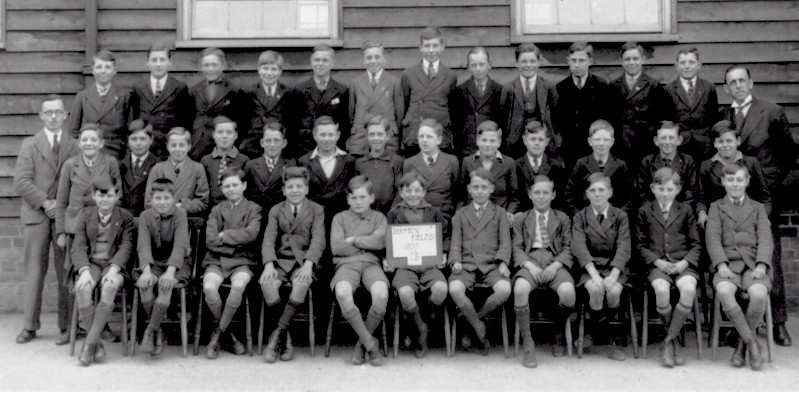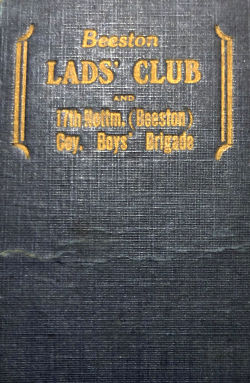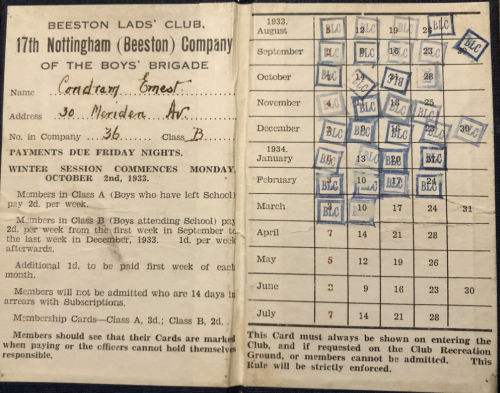Beeston Fields County Secondary School, Beeston - Class 2B, 1933

|
This picture of Class 2B is from 1933, the year after the school opened in September 1932. The school's first Headmaster, W A Brown, is on the right. The photograph
appears to have been taken outside what had been a temporary wooden classroom building that had been erected on the site, pending completion of the main school building. It was then remodelled as a
handicraft room and continued in use.
Philip Condran has kindly pointed out his father on this photo and has provided an insight into his life. Ernest is the fifth boy from the left on the middle row, the one wearing a double breasted jacket and a
striped tie. Born in Nottingham in 1920, he was the son of Ernest (1893-1975) and Elsie (1898-1988, née Boultbee) Condran. By the time of the photograph, the family - which also included a daughter, Vera -
were living at 30 Meridan Avenue (and later moved to number 3) on the newly-built Lenton Abbey Estate, a City of Nottingham housing estate that was included within the boundaries of Beeston before its transfer
to Nottingham in 1933, the year of this photograph. Infant and Junior children from Lenton Abbey as well as Senior boys continued to attend Beeston Fields School until relatively recent times. Ernest, and most
probably many of the others in the group as well as the Head Master and several of the staff, had previously been part of the boys' school that had been at Nether Street. It was converted to an all-girls school
after the boys' school move to Beeston Fields took place. Click to see Ernest there at 1931.
In August 1933, Ernest joined The Boys Brigade and Lads Club in Beeston and, as his membership card (below) shows, he was a regular attender for a while and took a full part in its activities
but appears to have stopped attending around the time he left school. He had wanted to join the Navy but, for the time being at least, his father would not consent to that so he started work locally - first
as a delivery boy for the Co-op before taking up a steadier job at Ericssons.
|
 |
|  |
|
In 1938, Ernest's father finally agreed to his entry into the Royal Navy, aged 17. Following guidance from his uncle, he joined the Torpedo Branch which then included electrical duties. In the
following year, of course, Britain was at war with Germany and the Royal Navy was vital to the defence of the English Channel. In 1940, Ernest was a member of the crew of HMS Foylebank, a converted 5,500 ton merchant ship that had been requisitioned by
the Royal Navy in September 1939 and converted into an anti-aircraft ship, assigned to such duties - in particular anti-aircraft defence - and, as such, was seen by the enemy as a threat to its attempts to destroy Britain's coastal shipping.
On 4 July 19140, while in Portland Harbour, she was attacked by 26 Junkers Ju 87 Stuka dive bombers. In the eight-minute attack, upwards of 22 bombs hit the ship whilst the crew managed to shoot-down two of the attacking planes.
The ship was very badly damaged and sank the next day. Tragically, out of the crew of 298, 176 were killed and many were wounded - including Ernest although, after treatment his terms of service were
downgraded to 'hostilities only' medical status. He was, however, able to return to sea when he had recovered, first with HMS Fleetwood engaged on convoy escort duties. Subsequently he served on the Battleship King George V and the aircraft
carrier Formidable. He finished the war as a Petty Officer on Formidable off the coast of Japan and returned home from Australia in 1946.
During the time that he had worked at Ericssons, Ernest had met Betty Hadfield who was also working there then and continued to do so during the war years. Born in 1921, she was the daughter of Thomas William Hadfiels (1892-1954)
and his wife Mary (1897-1948 née Daws), The family had moved to George Avenue, Beeston from the Sherwood Lodge Estate where Thomas had been employed by the Seely family as a carpenter up to when when the estate was sold. Betty continued
to work at Ericssons and to continue to be in touch with Ernest. The relationship blossomed and, in May 1942, Ernest was able to get leave so that they were able to marry at Beeston Parish Church. Ernest would have liked to remain in the Navy after the war but
the injuries from 1940 precluded that so he found work at Chilwell Ordinance Depot and the couple made their home on Inham Road, Chilwell where they went on to raise their three sons. Later he took a job at Pearson Bros in Nottingham where
he became manager of the Works Department, a position which brought him into contact with Fisher Bendix who offered him a Branch Manager's job in Bristol and accordingly, in 1960, the family left to live there.
Ernest passed away in 2011, aged 91 and Betty in 2020, aged 99.
Other suggestions for names are most welcome
|
Close this window to continue
|  |